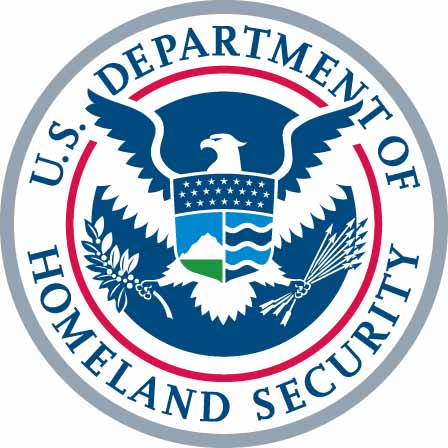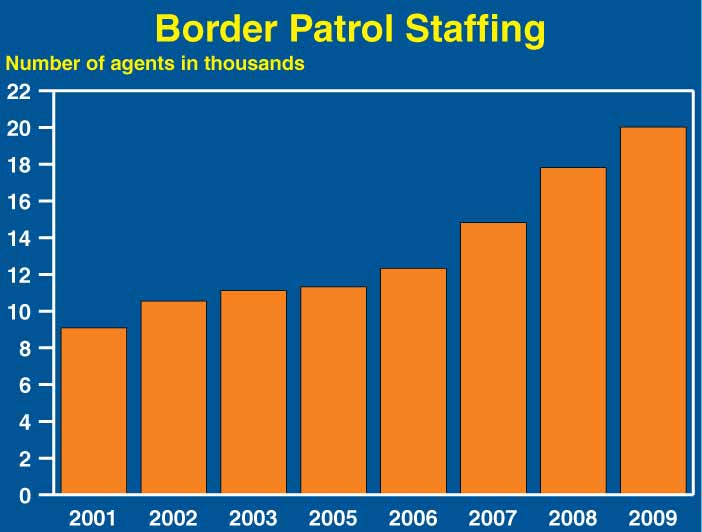DEPARTMENT OF HOMELAND SECURITY
The President’s 2009 Budget will:
-
Increase the Department’s capabilities;
-
Strengthen border security, interior enforcement,
and immigration services;
-
Enhance the security of the Nation’s transportation
system;
-
Reinforce maritime safety and security;
-
Fortify cyber security across the Federal Government;
-
Improve BioWatch capabilities; and
-
Expand the Federal Emergency Management Agency’s
operational capacity.
Increasing Homeland Security Capabilities
Strengthening Border Security, Interior Enforcement, and Immigration
Services
-
Increases Border Patrol agents.
Nearly $500 million for 2,200 new Border Patrol agents,
to accomplish the President’s goal of more than doubling the
size of the Border Patrol—from approximately 9,000 agents to
20,000 agents—since September 11, 2001.
-
Builds SBInet. Funding to ensure $2 billion over two years to continue to construct
the most effective mix of current and next generation technology,
as well as additional miles of fencing and other infrastructure to
protect the border.
-
Supports the Southwest Border
Counternarcotics Strategy. The increased 2009 investments
by the Department in personnel and technology will enable DHS and
partner agencies to capitalize on an array of intelligence and information
sharing programs to much more effectively confront all border threats.
-
Provides additional detention
beds. 1,000 new detention beds, bringing the total number
to 33,000 beds, to ensure the continuation of “catch and return.”
-
Partners with State and local
law enforcement. Expands the 287(g) program to improve
coordination and provide assistance and training in immigration law
for State and local law enforcement officials.
Additionally, this Budget supports key reforms in the programs
and systems that provide immigration benefits and services, such as:
-
Expands E-Verify, the Employment
Eligibility Verification Program. $100 million to continue
expansion and enhancements for the Internet-based system that helps
participating U.S. employers hire and maintain a legal workforce.
-
Reforms existing temporary-worker
programs. Proposes changes to the H-2A, H-2B, and H-1B
programs to streamline the process for U.S. employers to hire the
labor they need when no Americans are available, while also providing
for appropriate labor protections for workers.
-
Improves the background check
process for immigration benefit applicants. Takes steps
to eliminate the existing
backlog of pending FBI name checks and prevent any new backlog.
Enhancing the Security of the Nation’s Transportation
System
-
Devotes nearly $6 billion
to the multi-layered, risk-based aviation security system.
-
$3 billion for over 48,000 Transportation Security
Officers and technologies to screen passengers and their baggage for
weapons and explosives.
-
$1.2 billion to recapitalize checked baggage screening
devices and accelerate deployment of inline systems that will increase
baggage throughput up to 300 percent. The Budget proposes a temporary,
four-year surcharge in the passenger security fee of $0.50 per enplanement
with a maximum increase of $1.00 per one-way trip. The additional
fee collections of $426 million would be deposited in the Aviation
Security Capital Fund to accelerate the deployment of optimal checked
baggage screening systems and address the need to recapitalize existing
equipment deployed immediately after September 11, 2001.
-
$128 million for enhancements at passenger checkpoints
to improve the detection of prohibited items, especially weapons and explosives, through the use of additional
sensors, such as whole body imaging, liquid bottle scanners, automated
explosive sampling, and cast and prosthesis scanners. The Transportation
Security Administration (TSA) will continue to provide specialized
training in the detection of suspicious behaviors, fraudulent documents,
and improvised explosive devices.
-
Nearly $100 million for air cargo security inspectors,
canine teams, and the Certified Shipper Program to achieve 100-percent
screening of passenger air cargo in 2010.
Enhances security assessments. Funds security assessments on more than 2.4 million individuals
in the Nation’s transportation system, including commercial
HAZMAT drivers, airport and port workers, and international airline
flight crews. In addition, TSA will continuously vet 13 million individuals
who have already undergone a security assessment. These assessments
will be based on terrorism and criminal information from the U.S.
intelligence community and FBI databases. And, TSA will assume the
watch list matching of over two million airline passengers daily with
the implementation of Secure Flight.
-
Addresses surface transportation
vulnerabilities. $37 million for surface transportation
security, including funding for nearly 100 inspectors to conduct risk-based
assessments in the largest mass transit and rail systems.
Reinforcing Maritime Safety and Security
-
Recapitalizes assets. $990 million to fund Integrated Deepwater Systems, a multi-year recapitalization
project for the Coast Guard’s aircraft and largest sea-going
ships that continues to build Maritime Domain Awareness, a major goal
outlined in the President’s National Strategy for Maritime Security.
-
Supports Transportation Worker
Identification Credentials (TWICs). Issues more than 100,000
TWICs to maritime workers to better safeguard U.S. ports. TWIC is
one of the world’s most advanced, interoperable biometric credentialing
programs and is powered by state-of-the-art technologies.
-
Builds on law enforcement.
$17.6 million in new funding to enhance Coast Guard intelligence
and investigative capabilities.
-
Supports the Marine Inspection
Program. $20 million in new funding for more marine inspectors
to ensure compliance with vessel safety and security standards and
to keep pace with the growth in maritime commerce.
Fortifying Cyber Security across the Federal Government
Improving BioWatch Capabilities
-
Upgrades the BioWatch Monitoring
System. Increases its investment in Gen 3, the next-generation
BioWatch technology, to enable the BioWatch system to become fully
automated and reduce detection times to as little as four hours.
Completes the full testing and multi-city pilots of Gen3 technologies and begins procurement and deployment.
Expanding Federal Emergency Management Agency's (FEMA’s)
Operational Capacity
-
Expands FEMA capabilities.
$215 million to allow FEMA to implement Phase II of the
Vision initiatives, including:
-
Completing the conversion of temporary, full-time
employees to permanent staff.
-
Updating the information technology and logistics
systems.
-
Meeting requirements of the Post-Katrina Emergency
Management Reform Act, such as through the establishment of regional
strike teams.
-
Improving emergency communications.
-
Provides grant support. $2.2 billion in support, primarily in the form of grants, to the
Department's State and local partners in homeland security. The Budget
continues to emphasize programs that distribute grant awards on the
basis of risk, and this year introduces a grant program to help States
implement Real ID requirements and provide a more efficient, merit-based
allocation of limited resources.
Since 2001, the Administration has:
-
Established the Department of Homeland Security, merging
elements of 22 disparate agencies into a department of 166,234 personnel
and $40.7 billion in resources.
-
Funded nearly 11,000 new Border Patrol agents, acquired
nearly 13,000 new detention beds, and constructed close to 100 miles
of new border fencing.
-
Provided over $27 billion to State, local, and tribal
governments to enhance first responder preparedness.
-
Created TSA, hired and trained a workforce, and deployed
sufficient technology to electronically screen 100 percent of airline
passengers and checked baggage.
-
Strengthened marine transportation system and cargo
supply chain security through the Container Security Initiative, Customs
Trade Partnership Against Terrorism, and the Maritime Transportation
Security Act; and awarded more than $1 billion in port security grants
to enhance the physical security of the Nation’s seaports.
-
Created the Domestic Nuclear Detection Office to detect,
identify, and track down the origins of nuclear and radiological materials
and help prevent terrorism.
-
Successfully protected the Nation’s leadership
and visiting heads of foreign countries against potential terrorism
and other threats, and helped maintain the integrity of the Nation’s
currency and financial systems, through the vigilant work of the U.S.
Secret Service.
Department of Homeland Security
(Dollar amounts in millions)
| |
2007
Actual |
Estimate |
| 2008 |
2009 |
|
|
|
|
|
| Spending |
|
|
|
| Gross Discretionary
Budget Authority: |
|
|
|
| Departmental Management
and Operations |
913 |
840 |
1,084 |
| Office of the
Inspector General |
99 |
109 |
101 |
| Citizenship and
Immigration Services |
180 |
−4 |
151 |
| U.S. Secret Service |
1,277 |
1,386 |
1,415 |
| Transportation
Security Administration |
6,028 |
6,315 |
6,423 |
| Federal Law Enforcement
Training Center |
250 |
267 |
274 |
| Immigration and
Customs Enforcement |
4,446 |
4,817 |
5,364 |
| Customs and Border
Protection |
6,332 |
7,875 |
9,494 |
| U.S. Coast Guard |
7,079 |
7,156 |
7,835 |
| National Protection
and Programs Directorate |
945 |
1,016 |
1,447 |
| Federal Emergency
Management Agency |
5,875 |
6,823 |
5,729 |
| Science and Technology |
848 |
830 |
869 |
| Domestic Nuclear
Detection Office |
481 |
486 |
564 |
| Total, Gross budget
authority |
34,753 |
37,916 |
40,749 |
| Less fee-funded
activities |
−2,976 |
−2,957 |
−3,139 |
| Total, Discretionary
budget authority (net) |
31,777 |
34,959 |
37,611 |
| Bioshield (non-add) |
— |
— |
2,175 |
| |
|
|
|
| Memorandum: |
|
|
|
| Budget authority from enacted supplementals |
7,669 |
5,719 |
— |
| Additional funding requirements |
— |
63 |
— |
| |
|
|
|
| Total, Discretionary
outlays |
39,897 |
41,071 |
44,043 |
| |
|
|
|
| Mandatory Outlays: |
|
|
|
| Citizenship and
Immigration Services |
1,655 |
2,390 |
2,539 |
| Customs and Border
Protection |
1,035 |
2,281 |
1,463 |
| U.S. Coast Guard |
1,234 |
1,395 |
1,513 |
| Transportation
Security Administration |
95 |
424 |
287 |
| Legislative proposal |
— |
— |
320 |
| All other |
−4,730 |
−5,209 |
−5,856 |
| |
|
|
|
| Total, Mandatory
outlays |
−711 |
1,281 |
266 |
| |
|
|
|
| Total, Outlays |
39,186 |
42,352 |
44,309 |
| |
|
|
|
| Credit activity |
|
|
|
| Direct Loan Disbursements: |
|
|
|
| Disaster Assistance |
162 |
160 |
160 |
|
|
|
|
|
| |
Number of Programs |
|
2009 Savings |
| Major Savings, Discretionary |
|
|
|
| Reductions |
1 |
|
−1,905 |
|
|
|
|
|
|
 Skip Main Navigation
Skip Main Navigation

